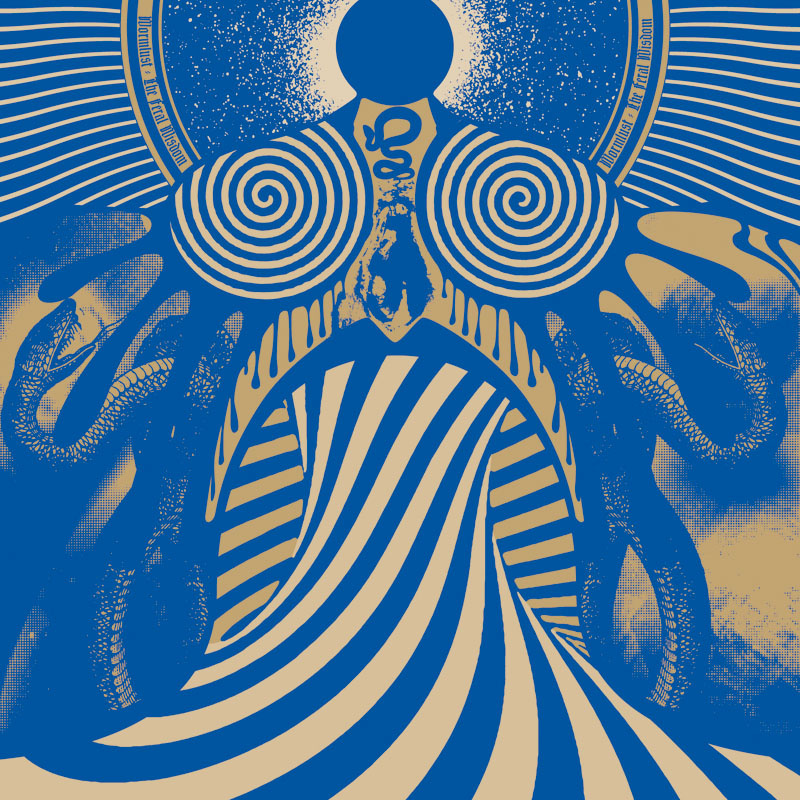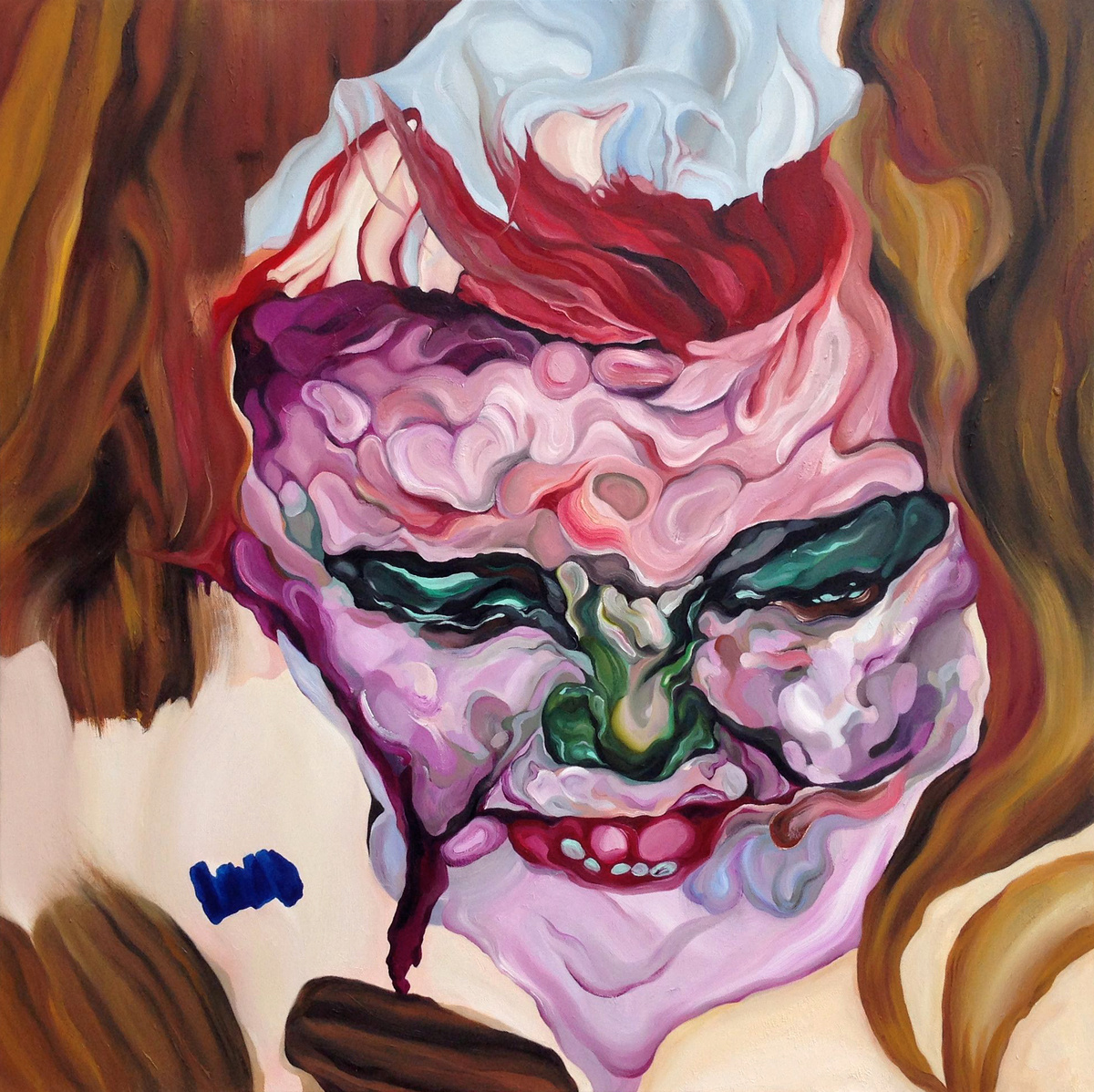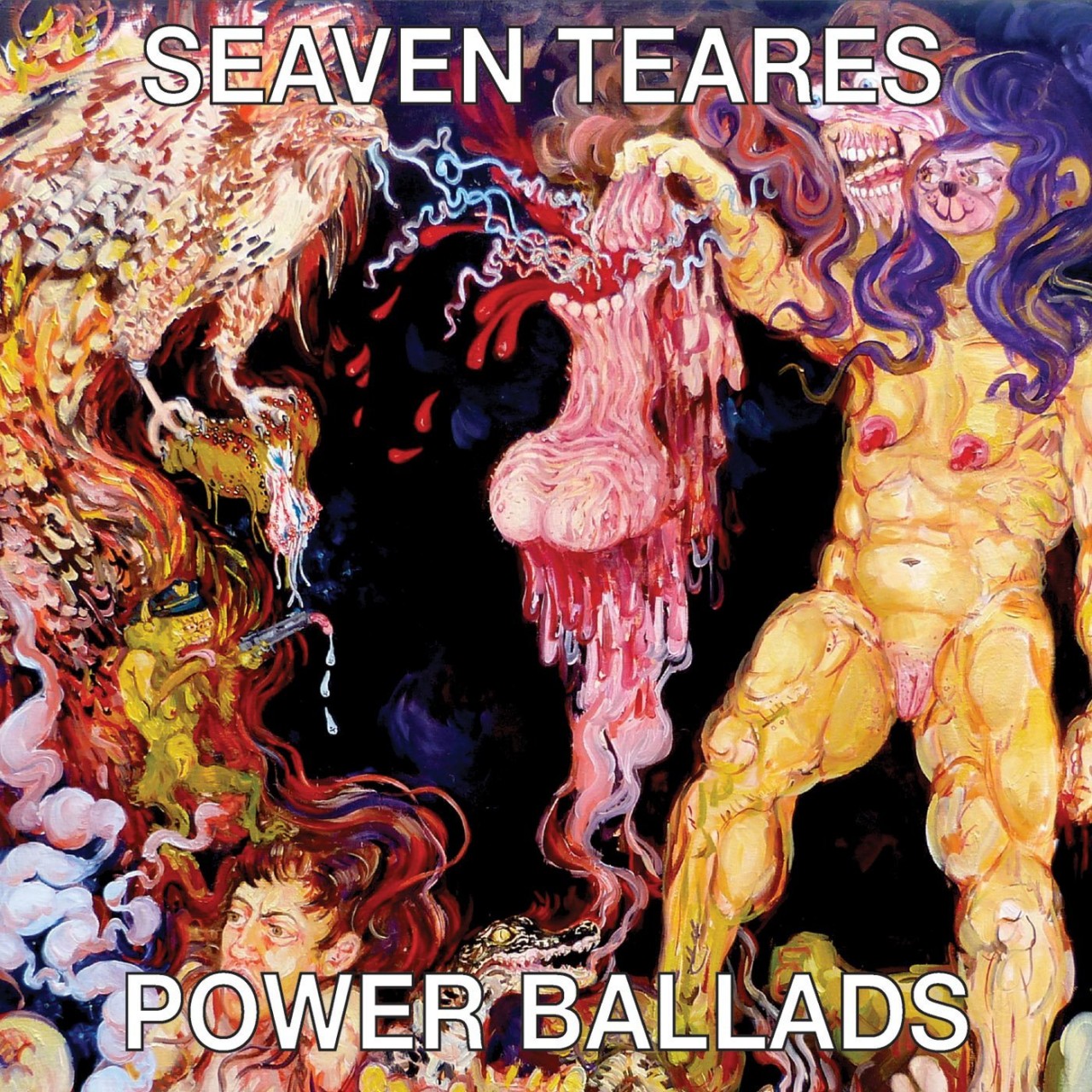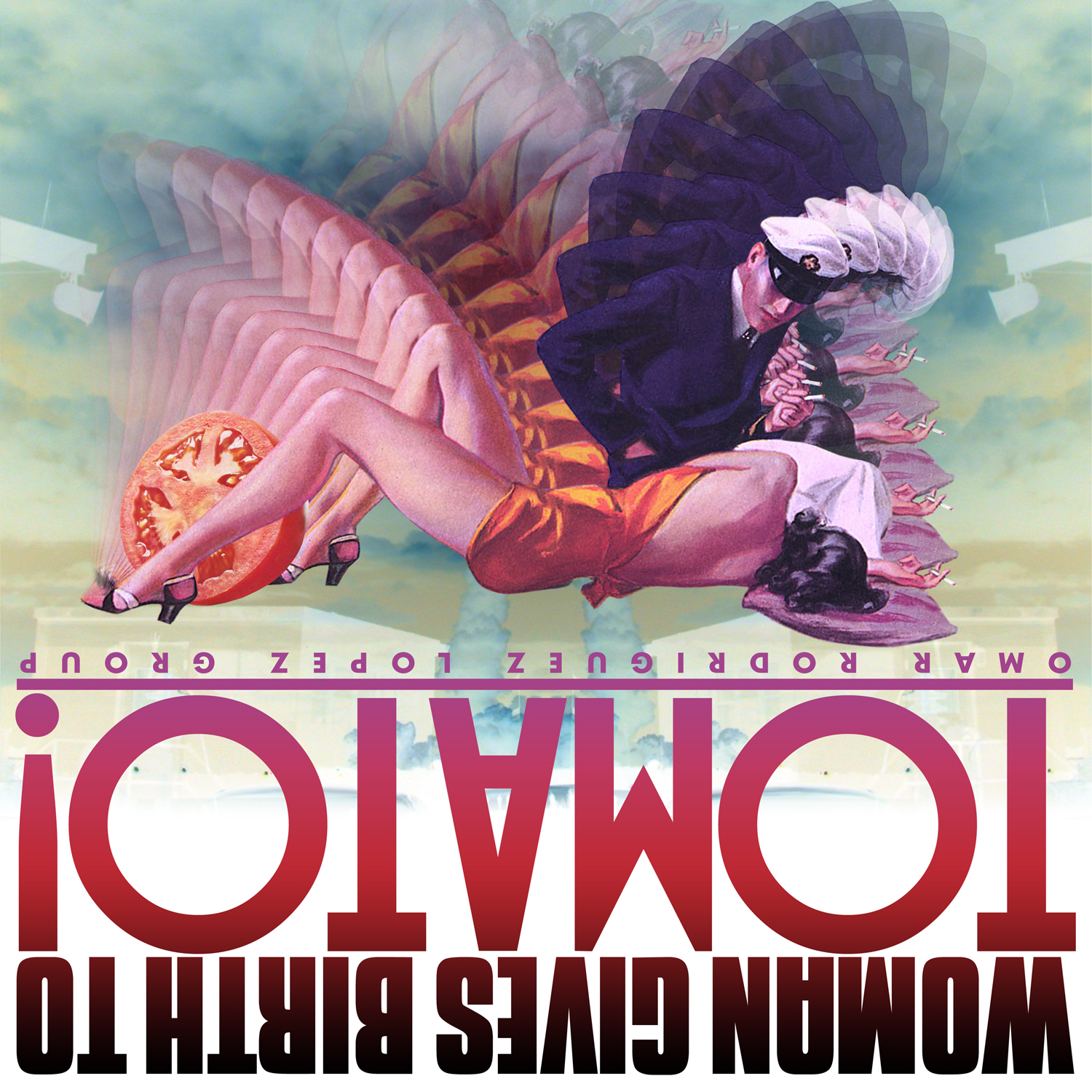We celebrate the end of the year the only way we know how: through lists, essays, and mixes. Join us as we explore the music and films that helped define the year. More from this series

20
Conforce - Kinetic Image
Artist: Graphic Surgery
[Delsin]
Techno and street art collide with minimalism and heavy industry on this Process Art-inspired cover. Made with spray paint and stencils, six rows of six “steps” create neo-Cubist rhythms from a grid of brash linear contours and intersections arranged across a blank surface. On projects like Electricity (2011) and Gateway (2013), Amsterdam-based art-and-design duo Graphic Surgery quote the angular silhouettes of the urban-industrial environment in muralistic meditations on color and motion. This ludic puzzle of line and form venerates mechanization in terms of grace and purity.

19
BOY FROOT - LOOTERS MIXTAPE
Artist: Jay Harmon
[Self-Released]
The compositional structure of this mixed media collage may contain a sly allusion to the cover of The Next Day that is easily lost within a discordant blend of unsettling juxtapositions. A cheap horror-punk font splatters clumsily across the head of the page, partially obscuring a blur of monochrome inks. The viewer’s gaze is directed toward the margins by an opaque square of naively rendered Op Art that shimmers in the center of the frame. A glutinous substance dribbles over a pair of incongruous cartoonish eyeballs that address the viewer from within the square. To the right of the frame, three spectators gather warily in the background while an attentive police dog bares its teeth at an unseen master. To the left, two indistinguishable policemen stare off-page right, themselves seemingly daunted behind their symbols of authority. Rapper-producer-painter Jay Harmon, a senior-year student at the Art Academy of Cincinnati, uses crude photomontage techniques and deliberately clumsy ornamental frills to convey a mood of sardonic menace.

18
Wormlust - The Feral Wisdom
Artist: Metastazis
[Demonhood]
The enigmatic French designer Sect Metastazis has built up an impressive client-base within the fervid microclimate of the Black Metal underground, with a portfolio including covers for the likes of Heretoir, Watain (screen-printed in his own blood), Lutomysl, and Ascension. His manifesto may be uncompromising — “Metastazis does not obey its clients” is one of many slogans discouraging a lengthy consultation process — but his prowess is easily perceivable. On the cover of The Feral Wisdom, anxious serpents cower before a planet-headed seraphic figure that springs from the page in a festival of coiled lines. Bold contrasts and anamorphic mischief characterize this deceptively simple game of reflections. Describing his intentions in an interview from 2011, Metastazis observed: “The big issue with the musical scenes I work with is that they take themselves far too seriously, to the point that you can’t take their message seriously… humor will make your message credible, human, and will bring people to reflection much more than a terrifying manifesto about the end of the world written in old Romanian.”

17
Old Apparatus - Compendium
Artist: OA1
[Sullen Tone]
Red and gold outlines dominate this caliginous portrait, a three-color reworking of a two-color original. A monolithic robot-being, corona backlit in hooded robes, towers above the waves like a cybernetic Poseidon. The imposing halo and inscrutable mask-assemblage of this gigantic figure exaggerates the power of the anonymous artist-producer, although the use of obsolete machinery implies that deterioration is possible at any moment. The members of elusive audio-visual collective Old Apparatus tend to work alone, basing their distinctive sonic universe upon the ideas and associations brought up by individual readings of the uncanny visual creations of member OA1. Her ramshackle rust-and-guts aesthetic recalls the self-propelling metamechanical sculptures of Jean Tinguely and the post-apocalyptic musings of theorypunk Evan Calder Williams.

16
Ákos Rózmann - Images Of The Dream And Death
Artist: Stephen O’Malley
[Ideologic Organ]
This poetic organization of Far Eastern signifiers is rich with hallucinatory implications without being straightforward. Look closely: a maroon horizontal line supports a black square within a quadrilangular olive block. A large pair of eyes, nesting within prominent palpebral folds and a painted brow, hovers drowsily above the unmistakeable features of the Tibetan Snow Lion, which poke out of the square below. A slit between the Lion’s brow opens on to a rogue third eye, trailing from a tell-tale plume of smoke that traverses the two blocks. Take a step back: the brow of the Lion becomes a nose and a larger face appears, dominating the canvas. Between the eyes of this new face, the painted brow and trail of smoke also assume a human/seraphic aspect.
The Snow Lion symbolizes ecstasy: this imaginary being is said to bound across the mountain peaks of the Tibetan Plateau, its feet never touching the ground in a simulation of boundlessness. The three human eyes could conceivably suggest a psychoactive means of contact with supernatural states of bliss, although the contrast between the watchful, sinister expression of the Lion and the larger, fatigued human eyeballs makes it clear that such ingress is not to be taken lightly. O’Malley’s reputation as an avant-garde guitarist-composer is well-established, but the exquisite poise of his cover designs, informed by a lifelong engagement with sonic extremes, is also deserving of wider acclaim.

15
Gubia - Polillas Gusanas
Artist: Maureen Gubia
[Self-Released]
Maureen Gubia is an Ecuadorian painter and musician. With Matinée (2005), she compiled a series of mottled sketches that each attempted to portray “children at birthday parties in the company of hopeless adults.” Other works show off her considerable illustrative skills in combination with a flair for gaudy colors that seethe with weird energies. Ambivalence nestles within the polychromatic folds of her astonishing cover for Polillas Gusanas: the motive behind a smile is always harder to read behind violent splotches of melting face. Perhaps anxieties about ageing and death (witness the blood-red smear across the forehead) are being implied; perhaps the many faces of one person cannot be orderly expressed as a whole. Perusing the works in her online gallery, it’s hard to avoid the sensation of a dual Freudianism, where the cathectic slippages of Sigmund’s dream-works are rendered with the bleak intensity of Lucien’s paintings.

14
Seven Teares - Power Ballads
Artist: Dawn Frasch
[Northern Spy]
This terrifying image depicts a bloodbath of caricatural forms. A two-headed feminine monster, her sagging genitals incongruous between hypertrophic quads, crushes a snake underfoot. She contentedly offers a testicular carcass to her right, where an eagle chews on a visceral thread. Dawn Frasch’s painting on Power Ballads is one of the year’s most memorable covers. If the use of vibrant textures and spontaneous, irregular lines recalls the irrational compositions of Art Informel, the frenzied subject matter is characteristic of the artist’s preoccupation with the anxieties of embodiment. Her writhing, fluid figures exaggerate the complicated ebb and flow of aggressivity and sexuality, violence and gender, in a striking fashion that brings to mind the Necronautic principle of “comedy over tragedy: that is, incompleteness, rupture, and mess, over neatness, uniqueness, and transcendence.”

13
Omar Rodriguez Lopez Group - Woman Gives Birth To Tomato!
Artist: Jeff Jordan
[Rodriguez Lopez Productions]
This snazzy pair find themselves in a delicate situation. An over-sized tomato slice sits between the legs of its (human) mother, who sprawls across the center of the image in a glamorous dress. A commercial pilot smokes a cigarette at the mothers’ side, his attention focused on her at the expense of the infant nightshade. By offering a literal representation of its title, this collage-in-oils has all the strangeness of an improbable metaphor. The failure of either parent to address the viewer, and the kaleidoscopic churn of their limbs, suggest that the meaning of this private circuit of consolation will always be out of reach. Perhaps the tomato, alone at the moment of its original alienation, addresses the spectator as a fellow exile from the land of reason? (Bumper sticker reading: “we are the tomato”). Like the paintings of Jaroslaw Kukowski (above), Jeff Jordan’s work is strongly influenced by Surrealism, although Jordan’s proficiency as a commercial artist and flamboyant juxtapositions situate his distinctively Lowbrow compositions somewhere between the lucid psychedelia of Moebius’ bandes dessinées and the sibylline humor of Magritte.

12
Run The Jewels - Run The Jewels
Artist: Nicholas Gazin
[Fool’s Gold]
Two pale, ghoulish hands describe a stick-up scene with comic book vigor on Nick Gazin’s Run The Jewels cover. The dookie rope chain in the right hand has powerful old school connotations, while the fingerpistol on the left is an aggressive act of interrogation and/or a notice of intent to dispossess. In this sense, Gazin’s sleeve implies that exuberance and tradition are not mutually exclusive: the old school is something to be seized, customized, and passed on. Gazin’s imagery on the cover and inside the gatefold displays an eye for composition rooted in the improvised arrangements of sticker art. Gazin’s illustrative work for VICE and Fool’s Gold is prepossessing without being cute, and weird without being vague.

11
Nate Young - Regression “Blinding Confusion”
Artist: Nate Young
[NNA Tapes]
Multi-instrumentalist and illustrator Nate Young is known for attacking the page with the same zeal with which he attacks his instruments. In a TMT interview with John Crowell from 2011, he admitted: “When I first started drawing and playing music as a teenager, my ultimate goal was to make drawings with recordings on them.” The evocative sketch on the front of “Blinding Confusion” exaggerates the physical cost of performance and the stupefaction inherent in any technical framework. The rotting skeleton emphasizes the transcendental aspect of productivity in terms of the death of the ego, while, simultaneously, a confusion of ulnar and humeral folds aligned to the right of the frame emphasizes the tactile, dislocatory force of representation. The minimal use of red ink connects the disembodied eye in the left-hand corner with a single distal phalange, implying a violent (blood red) interrelationship between artist (sore finger) and spectator (disembodied gaze). A lifelong Michigander, Young has been explicit about the way in which his bleak aesthetic vision is informed by the day-to-day pressures of life in his home state.
We celebrate the end of the year the only way we know how: through lists, essays, and mixes. Join us as we explore the music and films that helped define the year. More from this series
